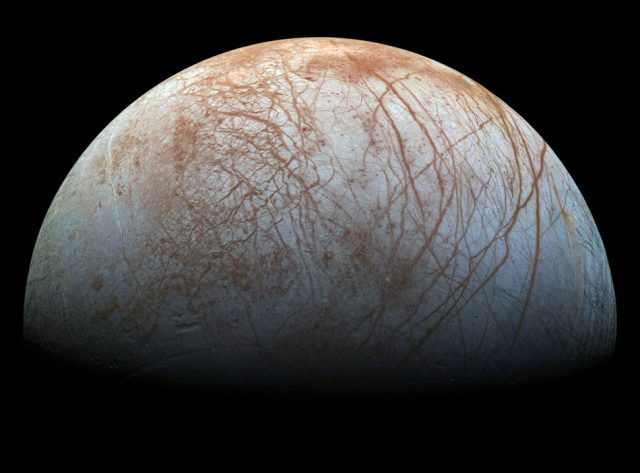
Is there life on other planets? While the massive number of exoplanets we've discovered has expanded the focus of this question outward, at the moment, our best chance for answering it remains within the Solar System. Here, we've floated above Europa, landed on Titan, and roved Mars, all of which have been put forward as possible homes for life. But so far, our attempts to get at the issue of life indirectly, by sensing its distinctive chemistry, have not provided a definitive result.
Now, a collaboration of European scientists argues that we don't have to rely on chemistry; life has a distinctive hum. Vibrations associated with basic metabolism can be detected using a sensor that's easy to make and extremely compact.
The collaboration's paper, released by PNAS, is a follow up on earlier work by the same group. It involves etching a microscopic lever (200µm long) that's sensitive to forces of as little as 0.06 N/m. The position of the lever could be tracked using laser light reflected off of it. With the device ready for use, they simply started attaching cells to it; plant cells, human cells, bacteria, and yeast. In each case, the presence of cells created vibrations. Treatment with a toxin that killed the cells returned these vibrations to background levels.
The researchers go on to examine what could be causing these vibrations. The authors check out a number of different cellular processes that could cause shifts. For example, E. coli propels itself through liquid in search of food using filaments called flagella. When it's in a high-sugar environment, the flagella stop in order to keep from moving the bacteria away from food. The authors were able to show that flooding the sensor with a sugar solution changed the vibrations, suggesting that some of them arise from flagella.
For more complicated eukaryotic cells, there's lots of internal movement, as cellular components are shifted along tracks called actin filaments and microtubules. We have drugs that disassemble these tracks, and the authors used these and showed that again, the resulting vibrations changed. In fact, they changed in stereotypical ways: "Large fluctuations of the sensor can be associated with movements inside the actin network whereas less intense but more frequent fluctuations can be attributed to the tubulin network."
All of which suggests that the sensors measure the results of basic cellular activity. To confirm that it's generally useful for sensing life, the authors pulled in samples from the soil, as well as water samples from a local river in Lausanne, Switzerland. Both of those showed the same sort of vibrations that are indicative of the presence of cells, as one might expect of the Earth's rich biosphere.
But could the sensor work outside our home planet? The authors certainly think so, advocating its use on future probes: "Due to the simplicity of its working principle, a device based on this technology has negligible weight and requires very low electrical power, compared with other life-detector systems." It's also able to complete a full cycle of detection in under a half-hour.
There are definitely some advantages of this approach. The biggest is that it doesn't depend on assumptions about our chemistry—we don't need to know whether alien life uses things like DNA and sugars in order to determine whether it's present. But there are also some serious caveats.
To begin with, it depends on attaching cells to the tiny levers, which the authors do by chemically cross-linking the cells. Getting that to operate in a harsh, alien environment might not be that simple, and it would mean that each lever is single use. Since they're only 200 microns long, that's not a space issue, but it will require very precise machinery to shift this tiny hardware into the right position for the sensors to read its output.
But there are probably more questions about the general approach. The authors' approach to a negative control is to simply kill the cells. But ultimately, we'll want lots of negative controls, using different samples from environments that don't contain significant life. We'll also want to test this on some more relevant samples, meaning cells that live in extremely harsh environments, such as the ones that are found deep in mines. In these organisms, metabolism is extraordinarily slow, and thus might not produce the same sorts of vibrations seen here. Arguably, these sorts of organisms are going to be more relevant examples for the sorts of life we'd find in the frigid, harsh conditions that persist on the other worlds of our Solar System.
But the prospect of a cheap, lightweight sensor that can detect life without any focus on specific chemistry makes these potential issues worth sorting out. Given the authors' publication record on the devices, they almost certainly are working on doing so.
PNAS, 2014. DOI: 10.1073/pnas.1415348112 (About DOIs).
reader comments
124